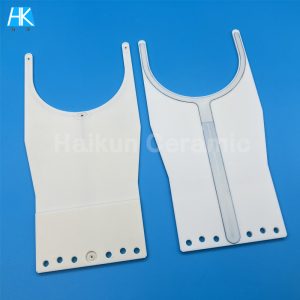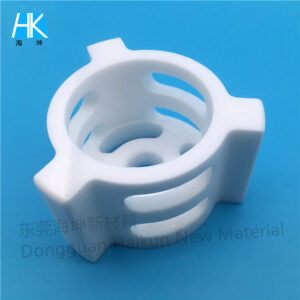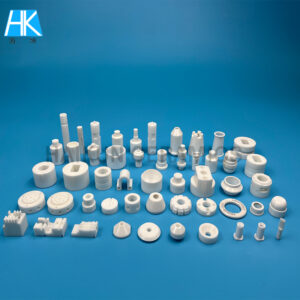Comparison of Precision Ceramic Material Properties
Not sure which ceramic material suits your application?
Use our interactive ceramic material comparison chart to compare ceramic materials based on different material properties.
Use our interactive ceramic material comparison chart to compare ceramic materials based on different material properties.
Click the Property Button above to view the corresponding property comparison of precision ceramic materials
*The values in the table are typical material properties
Detailed specifications of common precision ceramic materials
Zirconia(ZrO2) ceramics
*Some content and parameters are for reference only; our company can customize ceramic properties and processing according to customer requirements.
Primary characteristics
| Type | Unit | Zirconia | Zirconia(ZrO2-MgO) | ||
| Material | \ | 94.4% ZrO2-Y2O3 |
94% ZrO2-Y2O3 |
94% ZrO2-Y2O3 |
94.4% ZrO2-MgO |
| Colour | \ | White | Black | Blue | Yellow |
| Density | g/cm3 | 6 | 5.6 | 6 | 5.7 |
Mechanical properties
| Type | Unit | Zirconia | Zirconia(ZrO2-MgO) | ||
| Material | \ | 94.4% ZrO2-Y2O3 |
94% ZrO2-Y2O3 |
94% ZrO2-Y2O3 |
94.4% ZrO2-MgO |
| Colour | \ | White | Black | Blue | Yellow |
| Flexural Strength(20℃) | Mpa | 800 | 710 | 900 | 500 |
| Compressive Strength(20℃) | Mpa | 2000 | 2000 | 2000 | 2500 |
| Modulus of Elastic(young)(20℃) | Gpa | 200 | 210 | 220 | 250 |
| Tracture Toughness(20℃) | MPam½ | 9 | 8 | 8 | 6 |
| Poi sion’s Ratio(20℃) | \ | 0.3 | 0.3 | 0.3 | |
| Hardness HRA(20℃) | HRA | 88 | 85 | 90 | |
| Vickers Hardness(HV1) | kg/mm2 | 1175 | 1100 | 1220 | 1100 |
| Rockwell Hardness(45N) | R45N | 78 | 75 | 78 | |
Thermal properties
| Type | Unit | Zirconia | Zirconia(ZrO2-MgO) | ||
| Material | \ | 94.4% ZrO2-Y2O3 |
94% ZrO2-Y2O3 |
94% ZrO2-Y2O3 |
94.4% ZrO2-MgO |
| Colour | \ | White | Black | Blue | Yellow |
| Thermal Expansion Coefficient | 10-6K-1 | 9.6 | 9.5 | 10 | 10 |
| Thermal Conductivity | W/mk | 2.5 | 3 | 3 | 3 |
| Thermal Shock Resistance | △T.℃ | 250 | 300 | 300 | 450 |
| Specific Heat Capacity | J/g·k | 0.46 | 0.48 | 0.46 | |
| Max working Temperature(In Oxidizing) | ℃ | 800 | 800 | 800 | 2100 |
Electrical properties
| Type | Unit | Zirconia | Zirconia(ZrO2-MgO) | ||
| Material | \ | 94.4% ZrO2-Y2O3 |
94% ZrO2-Y2O3 |
94% ZrO2-Y2O3 |
94.4% ZrO2-MgO |
| Colour | \ | White | Black | Blue | Yellow |
| Vol une Resistivity at 20℃ | Ωcm | 1014 | 1010 | 1014 | 1014 |
| Dielectric Strength | KV/mm | 13 | 13 | 13 | 13 |
| Dielectric Constant | \ | 28 | 28 | 28 | 28 |
| Dielectric LossAngle at 20℃,1MHz20℃ | tanδ | 17*10-4 | 17*10-4 | 17*10-4 | 17*10-4 |
Alumina(Al2O3) ceramics
*Some content and parameters are for reference only; our company can customize ceramic properties and processing according to customer requirements.
Primary characteristics
| Type | Unit | Alumina | ||||
| Material | \ | 95% Al2O3 |
96% Al2O3 |
99% Al2O3 |
99.5% Al2O3 |
99.7% Al2O3 |
| Colour | \ | White | White | Ivory White | Ivory White | Ivory White |
| Density | g/cm3 | 3.7 | 3.7 | 3.85 | 3.9 | 3.9 |
Mechanical properties
| Type | Unit | Alumina | ||||
| Material | \ | 95% Al2O3 |
96% Al2O3 |
99% Al2O3 |
99.5% Al2O3 |
99.7% Al2O3 |
| Colour | \ | White | White | Ivory White | Ivory White | Ivory White |
| Flexural Strength(20℃) | Mpa | 300 | 300 | 330 | 360 | 380 |
| Compressive Strength(20℃) | Mpa | 2000 | 2000 | 2000 | 2350 | |
| Modulus of Elastic(young)(20℃) | Gpa | 270 | 275 | 370 | 370 | 380 |
| Tracture Toughness(20℃) | MPam½ | 3.5 | 3.5 | 4 | 4 | |
| Poi sion’s Ratio(20℃) | \ | 0.2 | 0.22 | 0.22 | ||
| Hardness HRA(20℃) | HRA | 90 | 90 | 90 | ||
| Vickers Hardness(HV1) | kg/mm2 | 1600 | 1600 | 1600 | 1650 | 1750 |
| Rockwell Hardness(45N) | R45N | 83.5 | 83.5 | 83.5 | ||
Thermal properties
| Type | Unit | Alumina | ||||
| Material | \ | 95% Al2O3 |
96% Al2O3 |
99% Al2O3 |
99.5% Al2O3 |
99.7% Al2O3 |
| Colour | \ | White | White | Ivory White | Ivory White | Ivory White |
| Thermal Expansion Coefficient | 10-6K-1 | 6.5 | 6.5 | 7.6 | 7.2 | 7.2 |
| Thermal Conductivity | W/mk | 20 | 25 | 27.5 | 32 | 32 |
| Thermal Shock Resistance | △T.℃ | 200 | 200 | 200 | 250 | |
| Specific Heat Capacity | J/g·k | 0.79 | 0.78 | 0.79 | ||
| Max working Temperature(In Oxidizing) | ℃ | 1600 | 1600 | 1650 | 1650 | |
Electrical properties
| Type | Unit | Alumina | ||||
| Material | \ | 95% Al2O3 |
96% Al2O3 |
99% Al2O3 |
99.5% Al2O3 |
99.7% Al2O3 |
| Colour | \ | White | White | Ivory White | Ivory White | Ivory White |
| Vol une Resistivity at 20℃ | Ωcm | 1014 | 1014 | 1014 | 1014 | 1014 |
| Dielectric Strength | KV/mm | 10 | 10 | 10 | 15 | 15 |
| Dielectric Constant | \ | 9 | 9 | 9.1 | 9.9 | 9.9 |
| Dielectric LossAngle at 20℃,1MHz20℃ | tanδ | 3*10-4 | 2*10-4 | 3*10-4 | 1*10-4 | 1*10-4 |
Silicon nitride(Si3N4) ceramic
*Some content and parameters are for reference only; our company can customize ceramic properties and processing according to customer requirements.
Physical properties
| Material Properties & Physical Performance | Units | Typical Values |
| Density | g/cm3 | >3.2 |
| Hardness | HRA90 | |
| Vickers Hardness (Hv50) | HV0.5 | >1550 |
| Modulus of Elasticity | Gpa | 290 |
| Flexural Strength | Mpa | >600 |
| Compressive Strength | Mpa | 2500 |
| racture toughness | Mpam1/2 | >6.0 |
Thermal properties
| The rmodynamic property | Units | Typical Values |
| Maximum Use Temperature | ℃ | 1200 |
| Thermal Conductivity | W/(m·K) | 15-20 |
| Thermal Expansion Coefficient | 10-6/℃ | >3.1 |
| Thermal Shock Resistance | △T℃ | 500 |
| Specific Heat Capacity | KJ/kg.K | 700 |
Electrical properties
| Electricl Protperties | Units | Typical Values |
| Dielectric Strength | KV/mm | 1 |
| Dielectric Constant | ||
| Volume Resistivity at 20°C | Ω.cm | 1.0×1012 |
Aluminum nitride(AlN) ceramic
*Some content and parameters are for reference only; our company can customize ceramic properties and processing according to customer requirements.
Primary characteristics
| Type | Unit | Aluminum Nitride |
| Material | \ | ALN |
| Colour | \ | Gray |
| Density | g/cm3 | 3.3 |
Mechanical properties
| Type | Unit | Aluminum Nitride |
| Flexural Strength(20℃) | Mpa | 470 |
| Compressive Strength(20℃) | Mpa | 2100 |
| Modulus of Elastic(young)(20℃) | Gpa | 320 |
| Tracture Toughness(20℃) | MPam½ | 2.6 |
| Poi sion’s Ratio(20℃) | \ | 0.24 |
| Hardness HRA(20℃) | HRA | 87 |
| Vickers Hardness(HV1) | Gpa(kg/mm2) | 1122 |
| Rockwell Hardness(45N) | R45N | 78.5 |
Thermal properties
| Type | Unit | Aluminum Nitride |
| Thermal Expansion Coefficient | 10-6K-1 | 4.6 |
| Thermal Conductivity(20℃) | W/mk | 170 |
| Thermal Shock Resistance | △T.℃ | 400 |
| Specific Heat Capacity | J/g·k | 0.72 |
| Max working Temperature(In Oxidizing) | ℃ | 1000 |
Electrical properties
| Type | Unit | Aluminum Nitride |
| Vol une Resistivity at 20℃ | Ωcm | 2.75*1014 |
| Dielectric Strength | KV/mm | 17 |
| Dielectric Constant | \ | 8.38 |
| Dielectric LossAngle at 20℃,1MHz20℃ | tanδ | 3*10-3 |
Silicon Carbide(SiC) Ceramic
*Some content and parameters are for reference only; our company can customize ceramic properties and processing according to customer requirements.
Primary characteristics
| Type | Unit | Silicon Carbide |
| Material | \ | SiC |
| Colour | \ | Black |
| Density | g/cm3 | 3.1 |
Mechanical properties
| Type | Unit | Silicon Carbide |
| Material | \ | SiC |
| Colour | \ | Black |
| Flexural Strength(20℃) | Mpa | 400 |
| Compressive Strength(20℃) | Mpa | 2600 |
| Modulus of Elastic(young)(20℃) | Gpa | 410 |
| Tracture Toughness(20℃) | MPam½ | 4 |
| Poi sion’s Ratio(20℃) | \ | 0.16 |
| Vickers Hardness(HV1) | Gpa(kg/mm2) | 2100 |
| Rockwell Hardness(45N) | R45N | 88 |
Thermal properties
| Type | Unit | Silicon Carbide |
| Material | \ | SiC |
| Colour | \ | Black |
| Thermal Expansion Coefficient | 10-6K-1 | 4 |
| Thermal Conductivity | W/mk | 100 |
| Thermal Shock Resistance | △T.℃ | 400 |
| Specific Heat Capacity | J/g·k | 0.67 |
| Max working Temperature(In Oxidizing) | ℃ | 1600 |
Electrical properties
| Type | Unit | Silicon Carbide |
| Material | \ | SiC |
| Colour | \ | Black |
| Vol une Resistivity at 20℃ | Ωcm | 105 |
Macor Ceramic
*Some content and parameters are for reference only; our company can customize ceramic properties and processing according to customer requirements.
Physical properties
| Material Properties & Physical Performance | Units | Typical Values |
| Colour | white | |
| Density | g/cm3 | 2.6 |
| Gas permeability | 0 | |
| Water Absorption | % | 0.00% |
| Hardness | R45N | 40 |
| Vickers Hardness (Load 500g) | Gpa(Kg/mm²) | 11.5(1175) |
| Modulus of Elasticity(25℃) | Gpa | 65 |
| Flexural Strength(20℃) | Mpa | 108 |
| Compressive Strength(20℃) | Mpa | 488 |
Thermal properties
| The rmodynamic property | Units | Typical Values |
| Maximum Use Temperature | ℃ | 800 |
| Thermal Conductivity(25℃) | W/(m·K) | 1.71 |
| Thermal Expansion Coefficient | 10-6/℃ | 7.2 |
| Thermal Shock Resistance | △T℃ | 200 |
Electrical properties
| Electricl Protperties | Units | Typical Values |
| Dielectric Strength | KV/mm | 30 |
| Volume Resistivity at 20°C | Ω.cm | 1016 |
Boron Nitride Ceramic
*Some content and parameters are for reference only; our company can customize ceramic properties and processing according to customer requirements.
Physical properties
| Material Properties & Physical Performance | Units | Typical Values |
| Colour | white | |
| Density | g/cm3 | 1.95±0.05 |
| BN Puriy | % | 99.5 |
| Hardness | Kg/mm² | 4 |
| Porosity | % | 15 |
| Flexural Strength(20℃) | Mpa | 22 |
Thermal properties
| The rmodynamic property | Units | Typical Values |
| Maximum Use Temperature | Oxygen-rich environment | 850℃ |
| 2000℃ | ||
| Thermal Conductivity(25℃) | W/(m·K) | 50-70 |
| Thermal Expansion Coefficient(25℃-1900℃) | 10-6/K | 1-1.2 |
Electrical properties
| Electricl Protperties | Units | Typical Values |
| RT Resistivity | Ω.cm | 1416 |
Guiding Questions for Material Selection
For your application in choosing the most suitable material, you may need to consider the following questions:
- What is the importance of mechanical performance?
- Will the parts experience wear, friction, or impact?
- How many units of the initial production batch are desired?
- Will the parts operate in an inert or oxidizing environment?
- What is the maximum operating temperature for the components?
- Will the components be subject to thermal shock?
- Is electrical insulation critical?
- How important is thermal conductivity?
- What is the significance of tolerances and surface finish?
Having trouble deciding? You can chat with us online or send us an email.

Why are more and more companies choosing ceramic plungers instead of metal ones?
In industries such as hydraulics, electric spraying, metering pumps, high-pressure cleaning, and fluid transfer, plungers are core components, and their lifespan and stability directly affect the overall performance of the machine. In the past, metal plungers were widely used due to their mature manufacturing process and low cost. However, in recent years, more and more…

Can ceramic carving be done with laser engraving? This article tells you the truth!
With the increasingly widespread application of precision ceramics, from industrial structural components to artistic ornaments, "ceramic carving" has become a hot topic of interest for many businesses and individuals. So, the question arises: Can ceramics be laser-carved? And what are the results?

The relationship between ceramics and semiconductors: unsung heroes supporting high-tech development.
In the semiconductor industry, we often hear keywords like chips, silicon wafers, and lithography machines, but few know that precision ceramics play a crucial role. It's not the main component, but rather the most solid support in the entire manufacturing system. From wafer fabrication to equipment components, ceramics, with their insulating, high-temperature resistant, corrosion-resistant, and…

What factors affect the heat dissipation performance of aluminum nitride ceramic plates?
The heat dissipation effect of aluminum nitride ceramic sheets is not determined by a single factor, but is the result of the combined effects of material properties, structural design and application conditions.

High temperature resistance, insulation, high purity – 99.7 alumina ceramic tube, a stable choice for scientific research and industry
In high-end industrial and scientific research fields, alumina ceramic tubes have become indispensable components in numerous devices due to their excellent high-temperature strength, insulation properties, and corrosion resistance. Among these, 99.7% high-purity alumina ceramic tubes (99.7% Al₂O₃ Tubes), with their higher purity and density, demonstrate unparalleled stability and reliability in high-temperature, high-pressure, and highly corrosive…

The future choice of high-performance materials: zirconia ceramic parts
In high-end manufacturing, the performance of materials often determines the quality and reliability of products. In recent years, zirconia ceramic components have been widely used in many industrial fields due to their excellent mechanical properties, excellent corrosion resistance and outstanding wear resistance.

Silicon Nitride Ceramics: The Future Star Of High-performance Materials
With the rapid development of industry and technology, the demand for high-performance materials is growing. Silicon nitride ceramics (Si₃N₄) have become a "star material" in the fields of aerospace, electronics, and medical due to their unique physical and chemical properties. This article will deeply analyze the characteristics, application scenarios, and market potential of silicon nitride…

Alumina Ceramics: Characteristics, Applications And Future Development Trends
Alumina ceramics (Al2O3 ceramics) are inorganic non-metallic materials with α-alumina as the main crystal phase. Due to its high hardness, high temperature resistance, good insulation and other characteristics, it is widely used in electronics, machinery, chemical industry, medical and other fields. Ingredients: The Al2O3 content is usually 75%~99.9%. The higher the purity, the better the…
